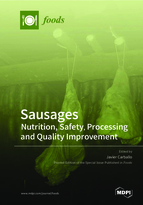Sausages: Nutrition, Safety, Processing and Quality Improvement
A special issue of Foods (ISSN 2304-8158). This special issue belongs to the section "Meat".
Deadline for manuscript submissions: closed (31 October 2020) | Viewed by 53664
Special Issue Editor
Interests: food quality; functional foods; fermented foods; meat products; meat product innovation; dairy products; cheese ripening
Special Issues, Collections and Topics in MDPI journals
Special Issue Information
Dear Colleagues,
Sausages are one of the oldest processed foods known to man. Several hundreds of varieties of sausages are produced worldwide with outstanding social and economic relevance. Each local variety within each sausage type (raw, cooked, or raw and fermented/ripened) reflects the availability of raw materials, the climate conditions of each geographical environment, the cultural and religious conditionings, and the ancestral manufacture knowledge transmitted through generations. Some sausage varieties are still unknown regarding their microbiological and biochemical features, or their production processes are insufficiently standardized. In other cases, there are safety or quality concerns that must be solved so that these sausages can be enjoyed to the fullest of their potential. The improvement of the sensory quality and/or the adaptation of their sensory and nutritional properties to changes in consumer preferences and requirements, all without sacrificing the personality and differential attributes of each sausage variety is in all cases a permanent challenge. For all these reasons further studies and research are essential instruments to improve and continue enjoying these privileged foods. This volume aims to gather the latest advances and to be a useful tool for the researchers and professionals in this scientific area.
Prof. Javier Carballo
Guest Editor
Manuscript Submission Information
Manuscripts should be submitted online at www.mdpi.com by registering and logging in to this website. Once you are registered, click here to go to the submission form. Manuscripts can be submitted until the deadline. All submissions that pass pre-check are peer-reviewed. Accepted papers will be published continuously in the journal (as soon as accepted) and will be listed together on the special issue website. Research articles, review articles as well as short communications are invited. For planned papers, a title and short abstract (about 100 words) can be sent to the Editorial Office for announcement on this website.
Submitted manuscripts should not have been published previously, nor be under consideration for publication elsewhere (except conference proceedings papers). All manuscripts are thoroughly refereed through a single-blind peer-review process. A guide for authors and other relevant information for submission of manuscripts is available on the Instructions for Authors page. Foods is an international peer-reviewed open access semimonthly journal published by MDPI.
Please visit the Instructions for Authors page before submitting a manuscript. The Article Processing Charge (APC) for publication in this open access journal is 2900 CHF (Swiss Francs). Submitted papers should be well formatted and use good English. Authors may use MDPI's English editing service prior to publication or during author revisions.
Keywords
- Additives
- adjunct cultures
- chemical features
- cooked sausages
- fermented sausages
- ingredients
- microbiological features
- nutritional quality
- raw sausages
- ripened sausages
- safety
- sausage manufacture
- spices
- starter cultures
- sensorial quality







